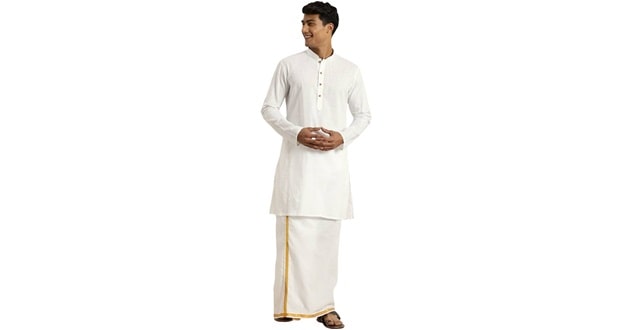South of the country, Andhra Pradesh is for sure one of the most culturally rich states in India, right? Well, you get to know about the culture of a place when meeting with the locals, and the very first thing everyone notices is definitely the attire and dress local people wear. Correct? That’s precisely why we are here, yes, to discover the true beauty of Andhra Pradesh by taking a good look at the traditional dress of Andhra Pradesh for men and women and their cultural significance. Alright, here we go now.
Traditional Dress of Men in Andhra Pradesh
In Andhra Pradesh, men’s traditional wear is designed to meet comfort, usefulness, and cultural values. So, let’s have a closer look at what men wear in this culturally rich area.
1. Dhoti
This is an essential part of Indian men’s culture. A dhoti is a strip of cloth, preferably cotton, which can be wrapped around the waist and legs. Its color is most of the time white or cream. The dhoti is most preferred for Andhra Pradesh’s hot and humid climate. It can be worn knee-length in informal settings and even ankle-length for very formal events.

2. Kurta
Worn with dhoti by men, the kurta is a long, loose shirt that drops to the knees. Kurtas are usually made of pure cotton, hence comfortable and flexible to the body. Plain kurtas are usually simple, but for special occasions, they may have some fine stitching or be made of silk to look more stylish. Kurtas come in long sleeves, three-quarter sleeves, or short sleeves, depending on the preferences of the wearer and the weather.
3. Shirts and Lungi
In every day or rather modern setups, men might wear shirts with lungis. Lungis are similar to dhotis but are sewn into a tube shape, which makes them easier to wear. This is in line with the fast pace of life today, and you can see most people wearing such attire on an everyday basis. Simply because it is super comfortable for them.
4. Traditional Footwear
Then there comes an open simplicity for shoes. Due to the tropical climate in Andhra, men will generally be found wearing open-toed sandals or slippers. On some special occasions, they may be seen adorned with traditional mojdis or juttis with their formal or daily comfortable attire/dress.
Traditional Dress of Women in Andhra Pradesh
Andhra Pradesh women put on traditional dresses that have a lot of history and art ingrained into them. Let’s get closer to what, in essence, traditional attire for women features in Andhra Pradesh.
1. Saree
A saree is an elegant costume of approximately 5 to 5.5 meters length of fabric, which is skillfully wrapped around the body. It is draped with a blouse covering the upper part of the body and a petticoat underneath for support. Most of Andhra Pradesh’s sarees are famous for their fine material and detailed weaving. Some of the varieties are Dharmavaram, Mangalgiri, and Uppada sarees. Each is named after the place from which it came, and they both have very many customers’ favorites due to their texture and patterns.
2. Langa Voni
This dress is also known as a half-saree and is generally worn by girls and teenage girls. This set comprises a skirt (Langa), blouse, and a dupatta (Voni) worn over the shoulder and around the waist. The Langa Voni is highly crucial since it is worn in a number of major life events, for instance, the celebration that marks the step of a girl into womanhood.
3. Accessories
Can any look be complete without the final touches in the way of accessorizing? You name it, Andhra Pradesh women always add jewelry to it. Women deck themselves with everything from gold necklaces to detailed earrings and bangles. The designs often show off local skills in making jewelry. Tribal jewelry, including items like beads, shells, and metals, is also worn by some groups, providing a traditional look with a natural touch.
4. Kalamkari Fabrics
Andhra Pradesh has a very distinct identity with its Kalamkari fabrics, which remain highly demanded for their hand-painted or block-printed patterns. The pen (kalam) and natural colors are used to paint images of Hindu gods, flowers, or mythological tales right on the fabric. Kalamkari sarees appeal not for their aesthetic beauty but for the cultural stories that they narrate.

